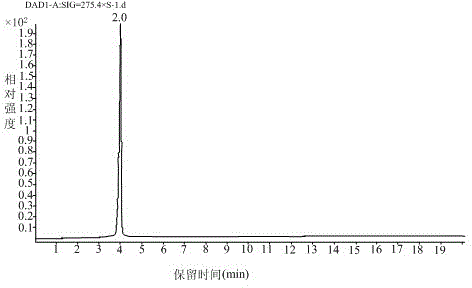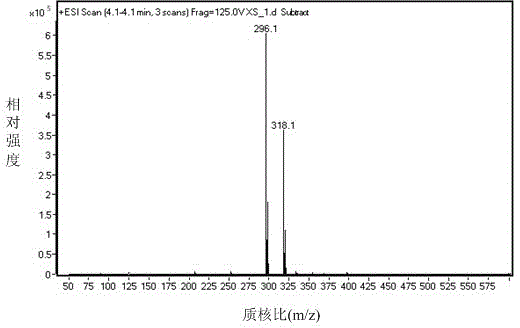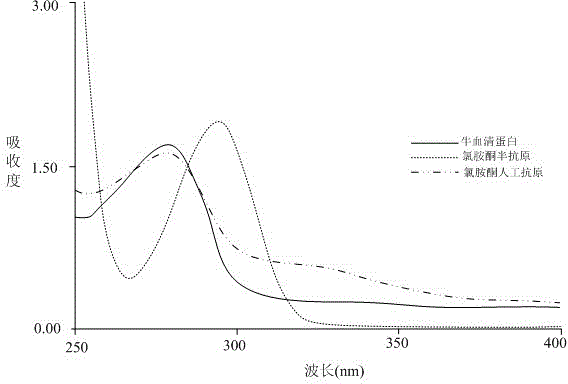Ketamine hybridoma cell strain and preparation method and application thereof
A hybridoma cell line, anti-ketamine technology, applied in the direction of biochemical equipment and methods, chemical instruments and methods, material inspection products, etc., can solve problems such as unsatisfactory, sensitivity limit of ketamine monoclonal antibody, etc., and achieve high sensitivity effect
- Summary
- Abstract
- Description
- Claims
- Application Information
AI Technical Summary
Problems solved by technology
Method used
Image
Examples
preparation example Construction
[0049] Step (1). Preparation of ketamine artificial antigen:
[0050] 1-1. Preparation and detection of ketamine hapten: use ketamine hydrochloride as raw material, carry out substitution reaction with ethyl bromoacetate after dissociation to introduce ester group, and obtain ketamine ester; hydrolyze under alkaline conditions to obtain carboxyl-containing ketamine hapten :
[0051] Dissolve 200mg of ketamine hydrochloride in 10ml of deionized water, add ammonia water to adjust the pH value to 10, add 90ml of dichloromethane to extract 3 times, collect the organic phase, dry with anhydrous magnesium sulfate, filter, and evaporate the solvent under reduced pressure to obtain free ketamine ; Free ketamine is detected by thin-layer chromatography: the chromatographic liquid is petroleum ether: ethyl acetate=1:1, product R f =0.3~0.4.
[0052] Dissolve free ketamine in 10ml of acetone, add 121μl of ethyl bromoacetate and 300mg of potassium carbonate, reflux at 70°C for 16h; coo...
Embodiment 2
[0077] Example 2 Performance testing of anti-ketamine monoclonal antibody
[0078] 2.1 Anti-ketamine monoclonal antibody subtype identification
[0079] The subtype of the anti-ketamine monoclonal antibody prepared in Example 1 was identified with reference to Monoclonal antibody Isotyping Kits (pierce #37501). The anti-ketamine monoclonal antibody belonged to the IgG1 subtype, and the light chain was a kappa chain.
[0080] 2.2 Reactivity test of anti-ketamine monoclonal antibody
[0081] The indirect ELISA method was used to detect the anti-ketamine monoclonal antibody prepared in Example 1: Dilute the ketamine artificial antigen (KET-BSA) to 1 ug / mL with a carbonate buffer solution with a pH of 9.6 and a concentration of 0.05M, and then in a 96-well microtiter plate Add 100ul diluted ketamine artificial antigen to each well, and coat overnight at 4°C; then wash the plate 3 times with PBS buffer containing 0.05%tween20; then add 100ul anti-ketamine monoclonal antibody solut...
Embodiment 3
[0084] Example 3 Establishment and Evaluation of Ketamine Colloidal Gold Test Strip Method
[0085] 1. Colloidal Gold Preparation
[0086] First prepare 20ml of 0.1g / L chloroauric acid solution, heat to boiling with a constant temperature electromagnetic stirrer, add 0.4ml of 1% trisodium citrate solution, continue heating and stirring for 10min, and replenish to the original volume with distilled water after cooling to normal temperature, to obtain Colloidal gold solution;
[0087] 2. Colloidal gold-labeled antibody protein
[0088] With 0.1mol / L K 2 CO 3 Adjust the pH value of the colloidal gold solution to 9.0, add 0.5 mg anti-ketamine monoclonal antibody protein dropwise; after continuing to stir for 3 minutes, add dropwise the BSA solution with a mass volume ratio of 5% until the mass volume ratio of the BSA solution is 1%, and continue stirring for 10 min. The antibody solution is obtained; wherein the anti-ketamine monoclonal antibody protein is the anti-ketamine mo...
PUM
 Login to View More
Login to View More Abstract
Description
Claims
Application Information
 Login to View More
Login to View More - R&D
- Intellectual Property
- Life Sciences
- Materials
- Tech Scout
- Unparalleled Data Quality
- Higher Quality Content
- 60% Fewer Hallucinations
Browse by: Latest US Patents, China's latest patents, Technical Efficacy Thesaurus, Application Domain, Technology Topic, Popular Technical Reports.
© 2025 PatSnap. All rights reserved.Legal|Privacy policy|Modern Slavery Act Transparency Statement|Sitemap|About US| Contact US: help@patsnap.com



